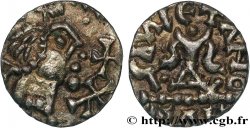bmv_242582 - MEROVINGIAN COINAGE - BANASSAC (BANNACIACO) - Lozere Triens, ELAFIVS monétaire
Not available.
Item sold on our e-shop (2013)
Price : 3 000.00 €
Item sold on our e-shop (2013)
Price : 3 000.00 €
Type : Triens, ELAFIVS monétaire
Date: (VIIe siècle)
Mint name / Town : Banassac
Metal : gold
Diameter : 14,5 mm
Orientation dies : 3 h.
Weight : 0,99 g.
Rarity : R2
Coments on the condition:
Très belle monnaie avec des types complets et une frappe relativement bien centrée, sur un flan un peu court. Bel aspect avec de très légères concrétions
Obverse
Obverse legend : ANÉPIGRAPHE.
Obverse description : Tête diadémée à droite, diadème et cou perlés, trois globules devant le visage et une sorte de grènetis autour.
Reverse
Reverse legend : ELAFIVS MONET.
Reverse description : Calice à deux anses, surmonté d’une croisette.
Commentary
Ce type de triens, proche du B. 650, est cosidéré comme étant au type de CHILDEBERT II (575-596). Avec un avers anépigraphe, le classement de ces monnaies reste hypothétique !.








 Report a mistake
Report a mistake Print the page
Print the page Share my selection
Share my selection Ask a question
Ask a question Consign / sell
Consign / sell
 Full data
Full data







